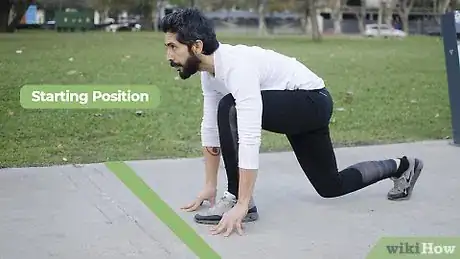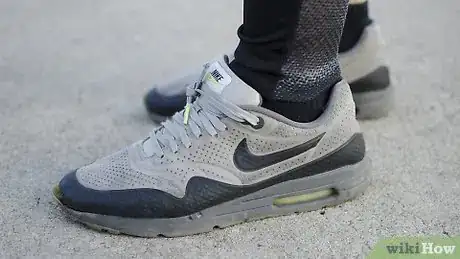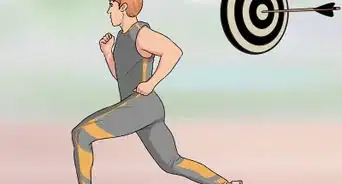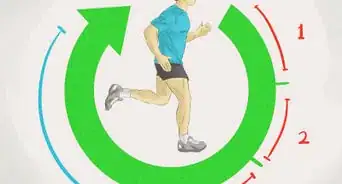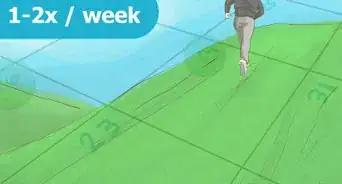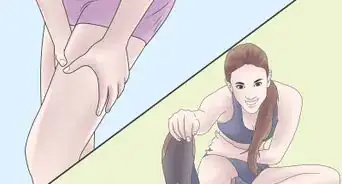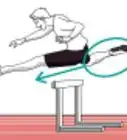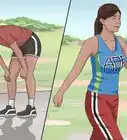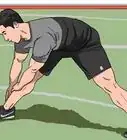This article was co-authored by Kai Ng. Kai Ng is a USATF and RRCA Certified Running Coach at Run Coach Kai. Kai has competed in over 55 races and over 15 marathons, and has trained with 16x USA and World record holder Patti Catalano Dillonso. He specializes in coaching runners of all levels and showing people that everyone can be a runner. Kai is committed to helping his clients reach their goals by showing them how to run with proper form and holding them accountable to train consistently.
This article has been viewed 112,790 times.
Whether you’re an athlete or just looking to incorporate sprinting into your workouts, you may be wondering how to sprint faster and improve your performance. The key to sprinting faster is warming up and using good form. This article will walk you through how to prepare in advance for sprints and how to use proper sprinting form so you can increase your speed the next time you go out running or hit the track.
Steps
Performing a Sprint
-
1Choose a starting position ("ready"). In general, you will want to begin a sprint crouched behind the starting line with your fingers on the ground and your legs positioned one behind the other. There are three types of starting positions: bullet or bunch starts, medium starts, and elongated starts. The type of start you choose depends on how far apart you want your legs to be when you begin your sprint. The best way to determine which starting position works best for you is to try each one several times. Regardless of your leg position, your arms should be about shoulder-width apart.
- In a bunch start, the toes of your back foot are almost even with the heel of your front foot. Your legs will be very close together, making you look bunched up - hence the name, "bunch start."
- In a medium start, the knee of your back leg is even with the heel of your front foot, putting more space between your legs.
- In an elongated start, your back leg is stretched back considerably further than the heel of your front foot.
-
2Find your balance ("set"). Before taking off, lift your hips slightly in preparation for a burst of movement.[1]Advertisement
-
3Take off ("go!"). In competitive sprinting, reaction time is crucial to achieving the best sprint time. Aim to launch from your "set" position instantly. It helps to have a timer close by or a friend to shout out an audible starting command; this is why they use a starting gun in competitive sprinting.
-
4For the first 10 meters (32.8 ft) or so, aim to keep your body low to the ground. You want your upper body to gradually rise from its starting position as your legs create the speed. It helps to look at the ground and concentrate on pumping your legs as quickly as possible.
-
5Between 10-20 meters, bring your torso to an upright position. Try to do this as gradually as possible, creating a fluid motion that helps you accelerate.[2]
-
6By the time you pass the 30 meter (98.4 ft) line, you'll be running at full speed. Maintain this speed until you reach the finish line.
Warming Up
-
1Do dynamic stretches. Dynamic stretches are exercises that loosen your muscles while boosting your heart rate.[3] You may have heard that stretching prior to exercising can be harmful; this piece of advice applies to static stretching, which involves elongating the muscle for an extended period of time. By choosing to do dynamic stretches, you lower the risk of inadvertently hurting yourself or decreasing your performance.[4] Some examples of dynamic stretches are:
- Hip circles. Standing with your hands on your hips and your feet slightly more than shoulder-width apart, rotate your hips clockwise. After a few repetitions, rotate your hips counter-clockwise.
- Leg swings. Stand next to a wall or fence for balance. With your right hand on the wall, swing your right leg backward and then forward for a few repetitions. Turn around and repeat with your left leg.
- Half-squats. Stand up straight, then slowly bend at the knee until your thighs are parallel with the floor. You might want to stretch your arms out in front of you for balance. When your thighs are parallel to the floor (about "halfway" down), slowly press back up, keeping your back straight.
-
2Do some light jogging or running prior to your sprint. Many runners find that sprinting is easier after they've already been exercising for a while. Since sprinting is often used as a last-minute boost of speed at the end of a long race, it can be helpful to practice sprinting after your muscles have warmed up considerably.[5]
Choosing Shoes and Clothing
-
1Choose the right shoes before you hit the track. There are seemingly endless options when it comes to fitness footwear. For competitive sprinting, the most useful type of shoe is known as a “spike.” It looks like a regular running shoe with pins under the toe which help you gain traction and improve your speed. These shoes are lightweight so that you can sprint faster.[6] If you're not planning on sprinting competitively you can safely wear other shoes for sprinting, such as:
- Other types of running "spikes." There are spikes for long distance, middle distance, field events, and even cross-country running. If you already own a pair of these, they will do fine for recreational sprinting.
- Lightweight training shoes or running shoes. Sometimes these are advertised as "spikeless" sprinting shoes. The important thing is that they are streamlined, with less bulk that will slow down your sprint time.
- Regular running shoes. These tend to be a bit bulky. They won't hurt you, but they might slow down your sprint time. If you're just starting out, these shoes will do in a pinch.
-
2Wear something you can move around in comfortably. If you're aiming for the fastest possible sprint time, wear something stretchy but form-fitting, like running pants. Otherwise, choose something breathable and comfortable.
Expert Q&A
-
QuestionWhat is the proper form for sprinting?
 Kai NgKai Ng is a USATF and RRCA Certified Running Coach at Run Coach Kai. Kai has competed in over 55 races and over 15 marathons, and has trained with 16x USA and World record holder Patti Catalano Dillonso. He specializes in coaching runners of all levels and showing people that everyone can be a runner. Kai is committed to helping his clients reach their goals by showing them how to run with proper form and holding them accountable to train consistently.
Kai NgKai Ng is a USATF and RRCA Certified Running Coach at Run Coach Kai. Kai has competed in over 55 races and over 15 marathons, and has trained with 16x USA and World record holder Patti Catalano Dillonso. He specializes in coaching runners of all levels and showing people that everyone can be a runner. Kai is committed to helping his clients reach their goals by showing them how to run with proper form and holding them accountable to train consistently.
Certified Running Coach Think of your back leg as the engine. For every push of the back leg, you're pushing your upper body forward. There is a hip drive forward and a front knee drive forward as well. Your arms are there to counterbalance your body and keep your center of gravity. The harder you push back, the harder your arm swings. Make sure you're looking at where you're going and keeping your hips squared as well. Stay nice and tall too.
Think of your back leg as the engine. For every push of the back leg, you're pushing your upper body forward. There is a hip drive forward and a front knee drive forward as well. Your arms are there to counterbalance your body and keep your center of gravity. The harder you push back, the harder your arm swings. Make sure you're looking at where you're going and keeping your hips squared as well. Stay nice and tall too. -
QuestionHow many hours should I practice?
 Community AnswerBuild it up gradually. You can't start by doing 10 hours a week, you could get hurt. Try 3 hours a week, and if you want to train more or if you have a goal in mind, practice more and more until you feel you are seeing adequate progress.
Community AnswerBuild it up gradually. You can't start by doing 10 hours a week, you could get hurt. Try 3 hours a week, and if you want to train more or if you have a goal in mind, practice more and more until you feel you are seeing adequate progress. -
QuestionI have limited stamina, but I'm very fast. At what point in a 100m race should I use my full speed?
 Community AnswerKeep a steady pace throughout the most of the race. Towards the end of the race, put on your burst of speed and sprint to the finish. The others that were sprinting the entire time will be tired at that point.
Community AnswerKeep a steady pace throughout the most of the race. Towards the end of the race, put on your burst of speed and sprint to the finish. The others that were sprinting the entire time will be tired at that point.
References
- ↑ https://www.brianmac.co.uk/sprints/starts.htm
- ↑ https://www.thespeedproject.com/sprinting/sprinting-technique/
- ↑ http://www.runblogrun.com/2012/05/coaching-101-warm-up-for-sprinters-by-roy-stevenson.html
- ↑ Kai Ng. Certified Running Coach. Expert Interview. 12 February 2021.
- ↑ http://www.runblogrun.com/2012/05/coaching-101-warm-up-for-sprinters-by-roy-stevenson.html
- ↑ https://www.myactivesg.com/Sports/Athletics/How-To-Play/Athletics-Equipment/Choosing-the-right-shoes-for-athletics
About This Article
Before you sprint, do some stretches and light jogging to warm up, which will reduce your risk of injury. Then, assume a starting position by crouching down with your fingers on the ground and one foot behind the other. Next, move into the "Set" position by raising your hips, and start running. During the first 10 meters, keep your body low to the ground and pump your legs quickly to build up speed. Afterwards, gradually raise your torso to help you accelerate, and maintain full speed until you reach the finish line. For tips on how to choose the best shoes and clothing for sprinting, read on!
